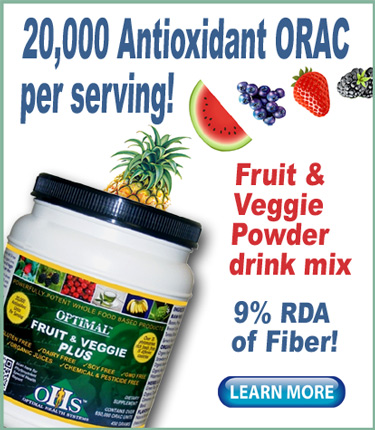A whopping 94% of American don’t get enough fiber in their diet. This is the conclusion from averaging two major recent studies.
A study presented at the Nutrition 2021 Live online conference, sponsored by the American Society for Nutrition, reported that 93% of Americans were failing to consume the recommended daily allowance (RDA) of fiber.
Researchers conducting this study used data gathered from 14,600 subjects participating in the National Health and Nutrition Examination Survey during the years 2013 to 2018.
The results of the study were strikingly similar to a study published in American Journal of Lifestyle Medicine in January 2017 that reported a failure rate slightly worse—at 95%.
RDA 25 grams for average person
The National Academy of Medicine (formerly called Institute of Medicine) established 14 grams of fiber for every 1,000 calories consumed as an “adequate intake.” This means the RDA for a standard 2,000-calorie diet would be 25 grams of fiber. And larger men, consuming a higher 2,500-calorie diet, would require 38 grams of fiber daily.
Researchers in the 2021 study found that women performed slightly better than men on average, but both were far short of the RDA: Women in the study consumed only 9.9 grams per 1,000 calories, while men consumed only 8.7 grams on average.
Achieving the fiber RDA requires consuming a good mix of fruits, vegetables and whole grains each day—a habit that is clearly lacking in the Standard American Diet.
The Standard American Diet, also referred to as Western Diet, is described by Wikipedia as: “A modern dietary pattern that is generally characterized by high intakes of pre-packaged foods, refined grains, red meat, processed meat, high-sugar drinks, candy and sweets, fried foods, conventionally-raised animal products, butter and other high-fat dairy products, eggs, potatoes, corn (and high-fructose corn syrup), and low intakes of fruits, vegetables, whole grains, pasture-raised animal products, fish, nuts, and seeds.”
Half the foods Americans eat are nutrient deficient
Surveys of Americans would agree: More than half of the calories Americans consume come from “heavily processed” foods, and on any given day nearly 40 percent of Americans eat fast food. These prepared and processed meals are not only low in fiber, some are completely fiber free!
Fiber’s health benefits are not derived from the nutrients it contains, but via its function. Fiber is a type of carbohydrate that passes through the body undigested, an action that conveys many benefits. Though perhaps best known for its role in supporting regular bowel movements, it’s the “regularity” that improves so many aspects of health.
Studies show that dietary fiber helps lower cholesterol, improves blood pressure and helps prevent diabetes.
For people who already have diabetes fiber is critical to help improve blood sugar levels.
Fiber for Gut Health
According to a study published in Microbial Ecology, just two weeks of a high-fiber diet can have a significant effect on the gut microbiome.
And a healthy gut microbiome leads to better nutrient absorption from all consumed foods!
The historical focus on the health benefits of fiber has waned in recent years with much attention being diverted to the anti-inflammatory health benefits of antioxidants. Ironically, though, many of the high antioxidant foods—fruits, veggies and berries—also provide fiber. So, increasing the intake of these foods will provide the dual benefits of antioxidants and fiber.
Low carb = low fiber
Contributing to the low intake of fiber is the popularity of low-carb diets. People are so busy avoiding carbs, they forget that carbohydrates provide important dietary components—like fiber.
Besides promoting regularity, it also attaches to toxins and helps the body eliminate them. Fiber is also essential for keeping the gut microbiome healthy. Without regular fiber the critical “healthy bacteria” become diminished.
In addition to fruits and vegetables, other sources of fiber include seeds, nuts and legumes.
Two types of fiber
It is also worth noting that there are two types of fiber: soluble and insoluble. They work in different ways, but both are considered beneficial for health.
Soluble fiber creates a gel as it dissolves, which helps to slow the absorption of sugar, improving blood glucose regulation. Insoluble fiber doesn’t dissolve in the same way, but does draw water into your stool so it’s easier to route through your digestive system.
Previous research shows connections between adequate fiber intake and blood pressure improvement, lower kidney disease risk, better gastrointestinal function, and weight loss and maintenance.
Perhaps the most critical health association is between fiber consumption and heart health. For example, research published in JAMA in 1996 found that participants with a high total dietary fiber intake had a 40% lower risk of coronary heart disease.
One way to boost fiber intake easily is by supplementing with Fruit & Veggie Plus from Optimal Health Systems.
Packed with dozens of fruits, veggies and herbs, each scoop of Fruit & Veggie Plus provides 3 grams of fiber—about 9% of the RDA.
Start lowering your risk of chronic diseases today with a scoop of Fruit & Veggie Plus. Click sidebar ad for more info.
– – –
Sources: Miketinas Abstract – presented at Nutrition 2021 Live, American Journal of Lifestyle Medicine (PubMed), JAMA (PubMed).


